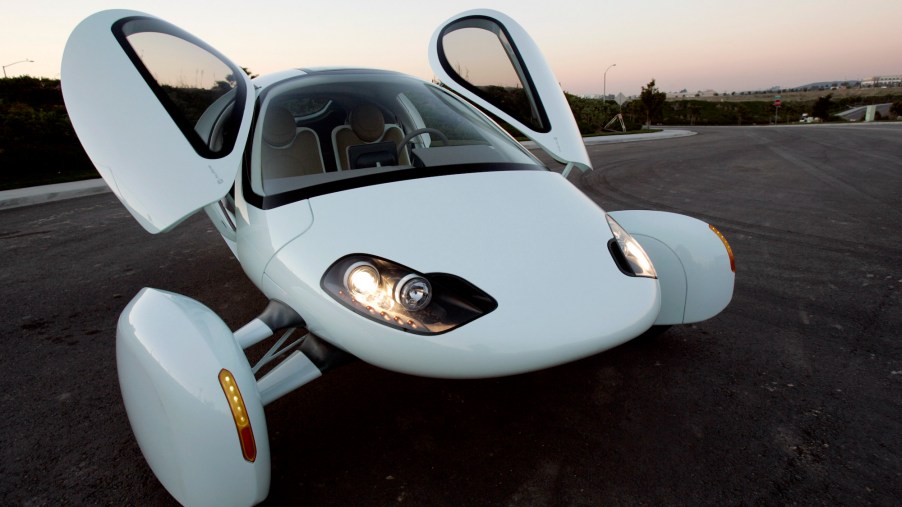
Can the Aptera EV Really Get 1,000 Miles on 1 Charge?
The age of electric vehicles is growing and evolving every day. One thing that makes consumers reluctant to consider EVs is the idea of charging the vehicle, particularly on long road trips. More charging stations for electric cars are coming soon, but many of us haven’t seen them yet.
Would you be more likely to consider an EV if it never required charging? Aptera is taking orders for an EV the auto manufacturer claims doesn’t need charging. Is such a thing possible? What does the company mean by a plug-in that doesn’t need to be plugged in?
What is Aptera Motors?
An American start-up headquartered in San Diego, Aptera Motors is a self-proclaimed efficiency-obsessed auto brand. It offers a lineup of comfortable, safe vehicles that the company says are a lot of fun to drive.
Aptera claims to have created an electric vehicle with a 1,000-mile range. If that’s true, it’s the longest range of any consumer EV produced so far. Using a combination of electricity and solar power, the car boasts an integrated solar component that can provide as much as 45 miles of range daily, the company claims.
How? This solar-powered EV, or sEV, has three square meters’ worth of 180 solar cells integrated into its design. The 45 miles of solar-powered range it reportedly boasts would cover many motorists’ daily commute.
The automaker estimates that if it manufactures a million vehicles, it’ll reduce our C02 footprint by as much as seven million tons annually. Aptera owners can cut down on their carbon footprint each year by 14,000 pounds each, or what 884 25-year-old pine trees can soak up in a year. If one of every 20 vehicles were an Aptera, the company explains, 18 million gallons of gasoline each year would be saved.
Aptera’s mission is to make innovative and efficient transportation that helps reduce the consumption of natural resources. The company also strives to optimize the use of materials in producing its vehicles.
Aptera’s new solar electric vehicle
Car and Driver describes the Aptera sEV’s appearance as an airplane fuselage without wings. The automaker explains that the design earns it a 0.13 coefficient of drag and allows it to use 100 watt-hours of energy each mile. When equipped with a 100-kWh battery pack, the Aptera sEV can get 1,000 miles of range, the company claims.
And drivers might never have to plug it in to charge it, unlike the plug-in hybrid models on today’s market. The company explains that the Aptera sEV uses a “never charge” solar roof array that can add up to 40 miles of range on a sunny day. Solar panels on the hatch and hood can add another 24 miles of range on a sunny day.
So, can this Aptera charge itself in real-time while driving with solar power? The automaker explains that unless you built an EV with next to nothing for drag and a ton of surface, probably not. For that reason, solar-powered cars in development are peculiarly shaped. But Aptera maintains that you can get five miles of range per hour for a solar charge rate with its latest vehicle.
The automaker isn’t saying much about horsepower yet. But the front-wheel-drive sEVs can go an estimated zero to 60 in 5.5 seconds. A three-wheel-drive should be able to hit 60 mph in 3.5 seconds.
The Aptera sEV will be available with various battery-pack sizes, from 25 kWh (250 miles of range) to 100 kWh. The heaviest model with the largest battery pack weighs 2,200 pounds, according to Car and Driver. The charge rate can get up to 500 miles of range per hour with DC fast charging.
Taking orders now
Aptera began taking orders for its new vehicle on December 4 with a refundable $100 deposit. The MSRP will start at $25,900 for the base model and climb to $46,000 with added options.
The initial sEVs will be called Paradigm and Paradigm+. It’s yet unknown if these names refer to two models or different trim levels. We do know there will be a model with higher ground clearance, an integrated awning and tent, and tougher wheel fairings potentially intended for overlanding.
The new Aptera sEVs are slated to debut in 2021.


